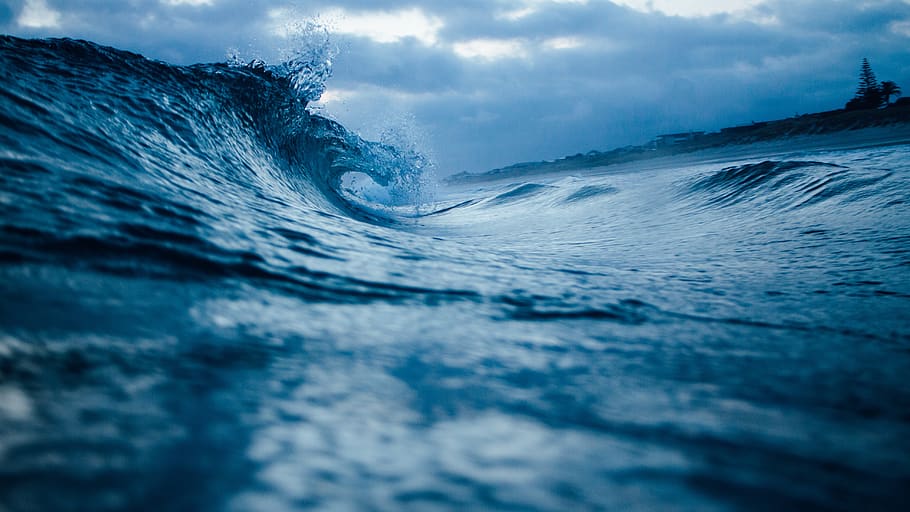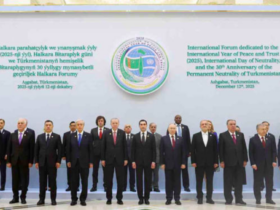By Tevfik Kadan
The humanity has left behind another tough year with many significant challenges. At the end of 2023 Palestinians raised the flag of revolt of oppressed nations against the oppressor world. Throughout the year, Russia’s achievements in Ukraine, led deep divisions on the West. France’s expulsion from Africa, the resolution of hitches in Karabakh, Syria’s return to the Arab League, the expansion of BRICS, and many more were the gains of the Eurasian front. While the US increasingly isolated itself on the international stage, the multipolar world order became a bit clearer. However, there was a challenge in 2023 that, even on its own, was capable of shaking the foundation of the “establishment”. This great challenge, only can be heard as a whisper for now, will shape the order of the coming era.
The hegemony of the US is based on maritime dominance. Emerging from World War II with 6,000 warships (it has 296 ships mow), the Americans have been able to assume the role of a global policeman. The ability to deploy power to any part of the world at any time is fundamental to the survival of hegemony. To maintain this capability, it is necessary to keep the sea routes always open. However, achieving this is not possible solely with naval power. That is why the principle of “freedom of the seas (Mare Liberium)” has been placed at the center of international law and protected by the US as if it were a divine law.
1.5 % of the world’s seas are closed waters
The boundaries of states’ maritime jurisdictional areas determine the extent of open seas that the US can “freely navigate.” In this regard, the general framework is framed by the United Nations Convention on the Law of the Sea, signed in 1982. The 1982 Convention divides maritime areas into regions such as territorial seas, continental shelves, Exclusive Economic Zones (EEZ), and the high seas. Of these, territorial seas are the only region with inherent rights. States are granted full sovereignty over their territorial seas with a width not exceeding 12 nautical miles.
The sea area beyond territorial waters is designated as the “Exclusive Economic Zone (EEZ)” extending up to 200 nautical miles, and beyond 200 miles it is referred to as the “high seas” or “open seas.” However, EEZs have been codified as a regime close to the “high seas.” Article 58 of the Convention states: “(All States), whether coastal or land-locked, enjoy, subject to the relevant provisions of this Convention, the freedoms referred to in article 87 of navigation and overflight and of the laying of submarine cables and pipelines, and other internationally lawful uses of the sea related to these freedoms, such as those associated with the operation of ships, aircraft and submarine cables and pipelines, and compatible with the other provisions of this Convention.”
Therefore, the extent of sea areas where full sovereignty can be exercised is roughly limited to about 1.5% of the world’s oceans. In the remaining sea areas, a liberal regime prevails. The global hegemony, not content with this, has even defined the right of “innocent passage” which allows for unauthorized passage through territorial waters.
What can be done in the open sea?
Let me provide an example to better understand the subject. The navy of any country in the world can pass its warships through the territorial waters of any coastal country under the name of “innocent passage” within the 12 nautical miles, and can conduct military exercises 13 miles beyond. In open sea areas, there is freedom of navigation, freedom of overflight, freedom to lay submarine cables and pipelines, freedom to build artificial islands and other facilities permitted by international law, freedom of fishing, and freedom of scientific research.
According to Article 89 of the Convention, “No State may validly purport to subject any part of the high seas to its sovereignty.” According to Article 90, “Every State, whether coastal or land-locked, has the right to sail ships flying its flag on the high seas.”
Thus, the principle of “freedom of the seas” is preserved in the 1982 Convention.
FONOP operations
This is exactly what the “rules-based international order” is that the US is trying to preserve. Also to protect this order, the Freedom of Navigation (FON) Program has been established. Officially initiated in 1979 during the administration of President Jimmy Carter, the program was confirmed with the Ocean Policy Statement by the Ronald Reagan administration in 1983 and has been implemented under all administrations since then. The objective of the Freedom of Navigation Operations (FONOP) conducted under the Program is officially stated as follows:
“Since the founding of the nation, the United States has asserted a vital national interest in preserving the freedom of the seas and necessarily called upon its military forces to preserve that interest. One of the first missions of a young U.S. Navy was to protect the safe shipping of U.S. commercial vessels through the Atlantic Ocean, the Mediterranean Sea and adjoining seas, against pirates and other maritime threats. Similarly, in President Woodrow Wilson’s famous Fourteen Points speech, he told Congress that one of the universal principles for which the United States and other nations were fighting World War I was ‘Absolute freedom of navigation upon the seas.’ And three months before the United States entered World War II, President Franklin Roosevelt delivered one of his fireside chats to the American people, in which he declared, ‘Upon our naval and air patrol … falls the duty of maintaining the American policy of freedom of the seas.’ As history shows, this U.S. national interest and policy for preserving the freedom of the seas are long-standing in nature and global in scope.
“As stated in the U.S. Oceans Policy (1983), the United States ‘will exercise and assert its rights, freedoms, and uses of the sea on a worldwide basis in a manner that is consistent with the balance of interests’ reflected in the Law of the Sea Convention. Some coastal states in the world have asserted maritime claims that the United States considers to be excessive– that is, such claims are inconsistent with the international law of the sea and impinge upon the rights, freedoms, and uses of the sea and airspace guaranteed to all states under that body of international law. The United States, however, ‘will not … acquiesce in unilateral acts of other states designed to restrict the rights and freedom of the international community.’”
What is the demand of Eurasia?
In 2023, the US Navy conducted more than 20 Freedom of Navigation Operations (FONOPs) citing “excessive maritime claims.” Warships were deployed to “contested areas,” challenging the coastal states’s sovereignty. For instance, on April 10, 2023, the USS Milius passed within 12 nautical miles of the Mischief Reef in the Spratly Islands, and on November 25, 2023, the USS Hopper operated near the Paracel Islands.
The statement from the US 7th Fleet on 27 November is significant as it includes objections from rival states:
“This freedom of navigation operation (“FONOP”) upheld the rights, freedoms, and lawful uses of the sea recognized in international law by challenging restrictions on innocent passage imposed by the People’s Republic of China (PRC), Taiwan, and Vietnam.
The PRC, Vietnam, and Taiwan each claim sovereignty over the Paracel Islands. All three claimants require either permission or advance notification before a military vessel or warship engages in “innocent passage” through their territorial sea, in violation of international law. Under customary international law as reflected in the Law of the Sea Convention, the ships of all States – including their warships – enjoy the right of innocent passage through a territorial sea. The unilateral imposition of any authorization or advance-notification requirement for innocent passage is unlawful. By engaging in innocent passage without giving prior notification to or asking permission from any of the claimants, the United States challenged these unlawful restrictions imposed by the PRC, Taiwan, and Vietnam. The United States demonstrated that innocent passage is not subject to such restrictions.
…
The United States upholds freedom of navigation for all nations as a principle. As long as some countries continue to claim and assert limits on rights that exceed their authority under international law, the United States will continue to defend the rights and freedoms of the sea guaranteed to all.
…
The operations demonstrate that the United States will fly, sail, and operate wherever international law allows – regardless of the location of excessive maritime claims and regardless of current events.”
The US claim is inconsistent with the Convention
The demands of Asian countries challenging the liberal order of the US have become the subject of academic studies in recent years. Considering that a multipolar world will bring about a new international law, leaders, intellectuals, academics, and youth in our country should allocate more time to these studies.
For instance, Associate Professor Lei Xiaolu from Wuhan University’s Institute of China Border and Ocean Studies, in a publication from 2023 titled “The ‘Freedom of Navigation’ Claimed by the United States is not Freedom of Navigation According to International Law,” develops the following response to the claims of the US:
According to the US Department of Defense report, freedom of the seas means not only freedom of passage for merchant ships, but also the use of air and sea by military vessels and aircraft. … Despite the best efforts of the United States to unite with its allies in negotiations to maintain the so-called freedom of navigation in traditional ways, the Convention ultimately aims to maintain a balance between the interests of maritime powers and coastal states. There has never been an unrestricted right of navigation in the Convention or in general international law.
…
Although foreign ships enjoy the right of innocent passage in the territorial sea, Article 25 of the Convention provides that the coastal state may take the necessary steps to prevent passage which is not innocent. That is, the coastal States have the right to decide whether the passage of a foreign ship is consistent with the “right of innocent passage” under Article 19. The Convention also provides that the coastal State may adopt domestic law on innocent passage and may require a foreign warship that disregards any request for compliance with domestic law to leave the territorial sea immediately. The Convention does not specify what steps and measures a coastal state may take or how a coastal state may ‘require’ a foreign warship to leave its territorial seas. The practice varies from State to State. There is clearly no right of navigation in the territorial seas of a coastal state that ignores its decisions. US warships may exercise the right of innocent passage, but at the same time must respect the coastal state’s determination of whether the passage is innocent and comply with the laws and regulations of the coastal State concerning passage through the territorial sea.
…
The United States upholds that the exclusive economic zone (EEZ), and the continental shelf only entitles the coastal state sovereign rights and jurisdiction related to the use of natural resources. In practice, however, the exercise of navigational rights in the EEZ should also take the obligation of ‘due regard’ under Article 58 into account. Article 58 does not specify which kind of interests need to be “due regard”. During the negotiation of the Convention, the issue of the limits and legality of military activities in the EEZ was discussed, and concerns regarding the security interests of coastal States were raised by Peru, Brazil, Uruguay and others. Until now, there is no consistent state practice among states on this issue. But at least, the right of navigation in the EEZ is limited by the jurisdiction of the coastal state regarding natural resources and marine environmental protection.
…
The United States is not a party to the Convention. In accordance with Articles 31 and 32 of the Vienna Convention on the Law of Treaties, subsequent practice of the parties is to be considered when interpreting the Convention. That is, the Convention is likely to evolve in accordance with the subsequent practice of the Parties. But as a non-party to the Convention, the practice of the United States means nothing for the interpretation of the Convention.
…
Therefore, if the United States wants to preserve its navigational interests, forcing its position through unilateral acts is not the best option. It must face up to and respect the space reserved by the Convention for coastal States to maintain their national security and resolve the relevant issues with the States concerned through bilateral or multilateral legal arrangements.”
Not only China
Indeed, China does not seem to be alone in these responses. Countries such as India, Vietnam, and the Maldives, among others, also oppose the passage of US warships through their territorial waters and Exclusive Economic Zones without their consent.
For instance, the “innocent passage” of USS John Paul Jones under FONOP through the territorial waters of the Maldives sparked a crisis between the two countries. The Maldives demanded that the US take permission before entering its territorial waters and Exclusive Economic Zone.
Once again, the passage of the USS John Paul Jones, this time 130 miles west of India’s Lakshadweep Islands, caused a similar crisis. India stated that the United Nations rules do not allow such a passage without consent. The spokesperson for the Indian Ministry of External Affairs made the following statement:
“The United Nations Convention on the Law of the Sea is that the Convention does not authorize other States to carry out in the Exclusive Economic Zone and on the continental shelf, military exercises or maneuvers, in particular those involving the use of weapons or explosives, without the consent of the coastal state.”
At that time, Admiral Arun Prakash, former Indian navy Chief had asked “Why is the US carrying out unauthorized maneuvers in the waters of an apparent ally? For the 7th Fleet to carry out FoN missions in Indian EEZ in violation of our domestic law is bad enough. But publicizing it?” in his Twitter account. Chinese diplomat Yu Dunhai delivered a more explicit message: “There is no such thing as ‘international waters’ in the United Nations Convention on the Law of the Sea. This is an invention created by the United States to exercise freedom of navigation.”
A third of the world’s seas would be closed to the US Navy
Today, the US utilizes the principle of “freedom of the seas” as a tool to enforce the continuation of the liberal order and its global hegemony. Modern maritime law has been shaped around this principle and countries’ full sovereignty areas are limited to territorial waters. However, the emerging new world, accompanied by security concerns, tends to lean towards the principle of closure of seas (Mare Clausum). If the 200-mile Exclusive Economic Zones beyond the territorial waters are characterized as areas of full sovereignty and function as territorial waters, this would mean the closure of one third of the world’s oceans to the US Navy. The US Department of Defense expresses this concern as follows: “In the USPACOM region, where EEZs account for 38% of the world’s oceans, it is assessed that leaving unchallenged excessive maritime claims could constrain the ability of the United States and other countries to conduct routine military operations or exercises in over one-third of the world’s oceans.”
In fact, it is also possible to find the basis of the claims of Eurasia for the new regime on the seas in international law.
For example, in the discussions of the 82 Convention, the concept of “patrimonial sea” is used as one of the concepts that constitute the basis of the EEZ. In 1972, the Santo Domingo Declaration confirmed the sovereign rights of countries over the “patrimonial sea”. The concept of EEZ also includes the continental shelf and the continental shelf is an ‘ab initio’ and ‘ibso facto’ right. According to the 1969 decision of the International Court of Justice in the North Sea Continental Shelf Case, the continental shelf is “the natural extension of the coastal State under the sea” and does not require any further declaration. In other words, it is intrinsically part of the homeland.
The freedom to lay cables and pipes in the EEZ granted to third countries is also prone to new practices. For instance, Malta enacted a law in 2014 to levy a tax on submarine cables passing through its continental shelf, and China, India and Russia have introduced the requirement to obtain authorisation prior to cable laying and repair activities. This is also confirmed by the provision in the Convention that “the rights and obligations of the coastal State shall be taken into account”.
Range crossing continents
Moreover, coastal states today have the military capability to protect a 200-mile maritime area. In history, the boundaries of the territorial sea have developed depending on the range of the cannon. Initially being 3 miles, the range increased to 5, 6 and 10 miles with technological developments, and was finally decided to be 12 miles in 1982. Today, armies have intercontinental missiles in their inventories. Many countries have advanced sensors, coastal batteries and cruise missiles that can protect a 200-mile maritime jurisdiction. Therefore, China’s new practices in maritime areas are also protected by weapons.
These practices will set precedents for other countries in the future, and perhaps an international maritime court will be established in Eurasia.
The aim of the developing world is not to prevent free trade, but to restrict the provocative activities of Western navies.
This will bring about the understanding that “the Mediterranean belongs to the Mediterraneans” in the future, just as it is the case in the Black Sea at present.
In short, whichever way you slice it, the world is heading towards Mare Clausum. This means that for the first time in history, we have entered the “Age of the Conquest of the Seas”.

















Leave a Reply